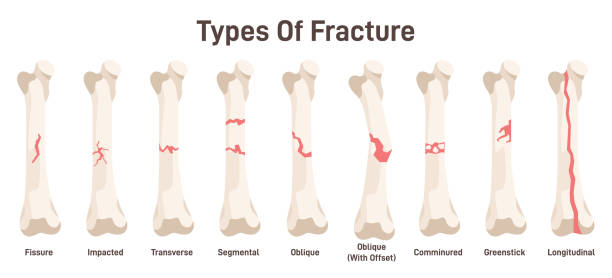Bone fractures, often a result of falls or accidents, encompass a wide spectrum of injuries. They can be as subtle as hairline cracks or as severe as shattered bones. To ensure proper healing and optimal recovery, understanding the different fracture types and their corresponding treatment options is essential. This article delves into the complexities of bone fractures, exploring various fracture classifications, common types, causes, diagnosis, treatment approaches, and the importance of follow-up care.
Understanding Bone Fractures
A bone fracture simply refers to a broken or cracked bone due to various reasons, like falls, accidents, or underlying medical conditions that weaken bones.
Classifying Bone Fractures
There are several ways to categorize bone fractures based on different characteristics. Here are four key classifications:
- Open vs. Closed Fractures: Open fractures, also called compound fractures, involve the broken bone protruding through the skin or creating an open wound, increasing the risk of infection. Closed fractures, or simple fractures, don’t pierce the skin, reducing the infection risk.
- Displaced vs. Non-Displaced Fractures: Displaced fractures occur when the bone fragments are misaligned, requiring manipulation or surgery for realignment and stabilization. In non-displaced fractures, the bone is broken but the fragments remain relatively intact, potentially leading to a quicker healing process.
Common Types of Bone Fractures
- Transverse Fracture: A straight break occurring perpendicular to the bone’s long axis, often caused by a direct blow.
- Spiral Fracture: Caused by a twisting force, the fracture line spirals around the bone shaft, resembling a staircase. Common in sports injuries and car accidents.
- Greenstick Fracture: Unique to children with flexible bones, a greenstick fracture involves a bend and partial break, resembling a green stick that bends but doesn’t snap completely.
- Stress Fracture: Tiny cracks or hairline fractures caused by repetitive stress or overuse, common in athletes and individuals engaged in high-impact activities.
- Compression Fracture: The collapse of a vertebra, often due to osteoporosis or trauma, causing pain, height loss, and curvature of the spine.
- Other Fracture Types: Additional fractures include oblique fractures (angled break), impacted fractures (one fragment driven into another), segmental fractures (multiple breaks), and comminuted fractures (bone shatters into multiple fragments).
Symptoms of a Bone Fracture
Symptoms can vary depending on the location and severity of the fracture, but common signs include:
- Pain, especially at the injury site, worsens with movement or pressure.
- Swelling and bruising around the injured area due to inflammation and bleeding.
- Visible deformity or misalignment in severe fractures.
- Difficulty or inability to move the affected limb or joint.
- Tenderness to the touch in the area around the fracture.
- Numbness, tingling, or weakness below the injury site if nerves are affected.
- Bone popping sound (crepitus), when broken bone ends, rub together.
- Visible bone protrusion in open fractures.
What Causes Bone Fractures?
- Trauma: Falls, sports injuries, car accidents, or direct blows to the bone.
- Repetitive Stress: Overuse or repetitive stress on a bone can lead to stress fractures.
- Osteoporosis: Weakens bones, making them more susceptible to fractures, especially in the spine, hips, and wrists.
- Pathological Conditions: Certain medical conditions like bone cancer, bone diseases, or infections can weaken bone structure and increase fracture risk.
- Age: Older adults are more prone due to decreased bone density, muscle mass, and impaired balance and coordination.
- Sports and Activities: High-impact activities like football or gymnastics increase the risk due to physical demands and potential falls or collisions.
- Accidents: High-speed collisions can cause severe injuries, including multiple fractures.
- Violence: Fractures can also result from intentional acts of violence.
Diagnosing Bone Fractures
Diagnosis typically involves a detailed medical history, physical examination, and imaging studies:
- Medical History: The doctor asks about the injury, symptoms, and any pre-existing medical conditions.
- Physical Examination: The doctor examines the affected area for tenderness, swelling, deformity, and changes in range of motion.
- Imaging Studies: X-rays are most common, followed by CT scans for complex fractures, MRIs for soft tissue injuries, bone scans for suspected but not visible fractures, and ultrasounds in specific cases.
Treatment Options for Bone Fractures
Treatment depends on the fracture type, location, displacement, patient’s age and health, and activity level. Here are some common approaches:
- Immobilization: The primary goal is to stabilize the fractured bone for proper healing using casts, splints, braces, or traction. Immobilization helps prevent further injury, reduces pain, and allows the bone to heal correctly in the proper alignment.
- Reduction: If the fracture is displaced, it may need realignment, a procedure called reduction. This can be done in two ways:
- Closed Reduction: Performed without surgery, a doctor manipulates the bone fragments back into their correct position.
- Open Reduction: Surgery is required to achieve proper alignment and stability. This may involve internal fixation using screws, plates, or rods, or external fixation using pins or screws placed outside the skin to hold the bones in place.
- Medications: Pain relievers like over-the-counter or prescription medications may be recommended to manage pain during healing. Additionally, medications to prevent infection or promote bone healing may be prescribed.
- Physical Therapy: Once healing begins, physical therapy exercises are crucial to restore strength, flexibility, and range of motion in the affected area. These exercises help prevent muscle atrophy, improve function, and facilitate a return to normal activities.
- Follow-up Care: Regular appointments with your healthcare provider are essential to monitor healing progress, assess treatment effectiveness, and make adjustments if needed. X-rays or other imaging studies may be repeated to ensure proper bone alignment.
Conclusion
Bone fractures can vary significantly in severity. However, with proper diagnosis, treatment, and preventive measures, most fractures heal completely, and individuals can regain full function. Early intervention is crucial for optimal healing and preventing future complications. If you have concerns about your bone health or have experienced a fracture, consult a healthcare professional for proper diagnosis and guidance.






